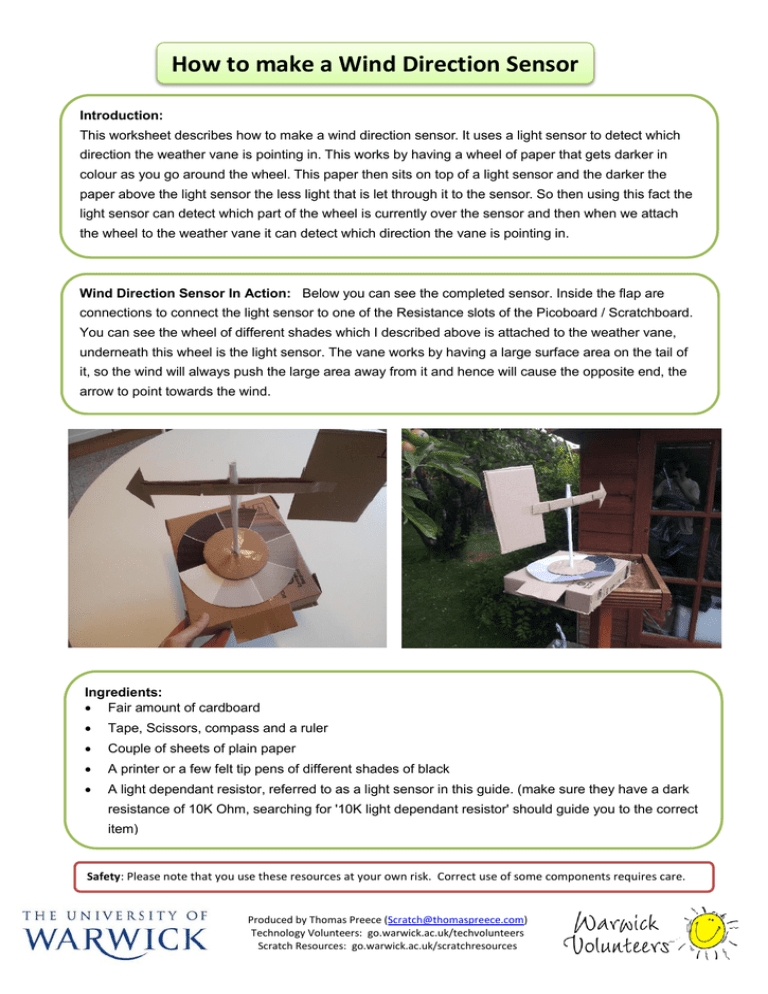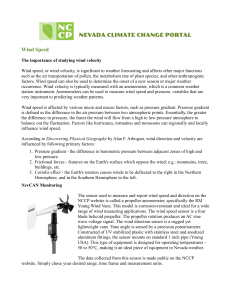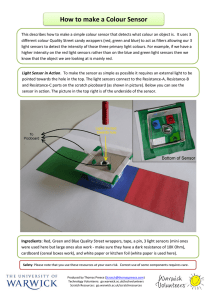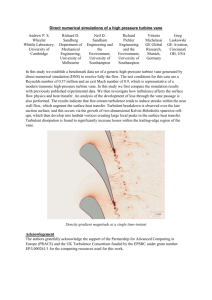How to make a Wind Direction Sensor
advertisement

How to make a Wind Direction Sensor Introduction: This worksheet describes how to make a wind direction sensor. It uses a light sensor to detect which direction the weather vane is pointing in. This works by having a wheel of paper that gets darker in colour as you go around the wheel. This paper then sits on top of a light sensor and the darker the paper above the light sensor the less light that is let through it to the sensor. So then using this fact the light sensor can detect which part of the wheel is currently over the sensor and then when we attach the wheel to the weather vane it can detect which direction the vane is pointing in. Wind Direction Sensor In Action: Below you can see the completed sensor. Inside the flap are connections to connect the light sensor to one of the Resistance slots of the Picoboard / Scratchboard. You can see the wheel of different shades which I described above is attached to the weather vane, underneath this wheel is the light sensor. The vane works by having a large surface area on the tail of it, so the wind will always push the large area away from it and hence will cause the opposite end, the arrow to point towards the wind. Ingredients: Fair amount of cardboard Tape, Scissors, compass and a ruler Couple of sheets of plain paper A printer or a few felt tip pens of different shades of black A light dependant resistor, referred to as a light sensor in this guide. (make sure they have a dark resistance of 10K Ohm, searching for '10K light dependant resistor' should guide you to the correct item) Safety: Please note that you use these resources at your own risk. Correct use of some components requires care. Produced by Thomas Preece (Scratch@thomaspreece.com) Technology Volunteers: go.warwick.ac.uk/techvolunteers Scratch Resources: go.warwick.ac.uk/scratchresources Step 1: First we are going to construct the base of the weather vane. You can make your base smaller or larger than the one I am making but note that a larger base makes the vane much more stable and allows you to make a much more sensitive wind direction sensor. Firstly take a square-ish piece of cardboard (mine was about 30cm x 30cm) and draw using a ruler a border of the same width around the cardboard and mark the centre of the cardboard with a cross like shown in the left image below. Next using your scissors score the cardboard along the lines and cut along one of the two lines at each corner as show below in the right image. Then fold the sides up and tape securely the corners to the sides to form an open top box as shown in the next step. Step 2: Next you need to cut a similar sized lid for your open top box. Make sure to make it slightly larger than your box so that it can rest on your box without falling inside. After that mark a cross in the centre of your lid. Very carefully use a pen/pencil to make a small hole where you made a cross on your open top box and on your lid. These holes are where your weather vane will go through. Tape the lid on to the box so that the holes line up. Produced by Thomas Preece (Scratch@thomaspreece.com) Technology Volunteers: go.warwick.ac.uk/techvolunteers Scratch Resources: go.warwick.ac.uk/scratchresources Step 3: Take your compass and on the bottom of your open top box draw the largest circle you can without the edges of the circle touching the edge of the bottom of the box. On the left side of the bottom face of the box and inside the circle you draw make a hole big enough to tightly fit your light sensor into. You should have something like the left image below. Fit the light sensor into the hole and tape it to the box on the outside and inside as shown in the right image. Make sure that when you tape it down so that the light sensor is flush with the rest of the box on the outside face. You will also want to cut a hole in the side for easy access to attach Picoboard/Scratchboard sensor leads to the light sensor as show in the right side of the right image. Step 4: Next we assemble the weather vane. Get a sheet of paper and fold it in half along the longest side. The fold it in half again in the same direction. Next take the longest side and fold it over about a single cm in width, fold it over again and again until your entire sheet is just a single cm wide (like in the fourth image below). Now tightly tape it together making sure to tape all the way along the edge. Now pick it up and press on the two long sides to change it from a flat long object to a round long object (like a cylinder) like in the last two images. Produced by Thomas Preece (Scratch@thomaspreece.com) Technology Volunteers: go.warwick.ac.uk/techvolunteers Scratch Resources: go.warwick.ac.uk/scratchresources Step 5: Next find some more cardboard (I used 30cm x 16cm) and draw a similar shape as I have in the left image below. It is however important that the vane has a large piece of cardboard at its tail and that the rest is quite small in comparison. (As an example my tail was 16cm x 10cm, whereas the rest is only 2cm in height, excluding the arrow head which is slightly larger but not as much as the tail). The larger you make the tail the easier it will catch the wind. Depending on how sturdy your cardboard is you may have to strengthen it along the smaller bits. I used the offcuts and cut them into small lengths and taped them on both sides as shown in the right image. Step 6: Now we need to attach the pole from step 4 to the vane from step 5. I did this by slotting it between my strengthening pieces made from offcuts and the original vane and then taping it together but attaching it anyway you can will work, just make sure you attach it roughly in the centre of the vane to keep it fairly balanced. See the image below for more clarity. Produced by Thomas Preece (Scratch@thomaspreece.com) Technology Volunteers: go.warwick.ac.uk/techvolunteers Scratch Resources: go.warwick.ac.uk/scratchresources Step 7: Next we need to cut a cardboard circle to stabilize our vane. The larger the circle the more stable the vane will be but when the vane is placed in the base it must not overlap the light sensor so we should make the circle a few centimetres smaller in diameter than the circle drawn on our base (I used a circle of diameter 11cm but I could of used a circle of up to about 16cm diameter). See in the right image how the cardboard circle doesn't overlap the light sensor. Step 8: You will then need to put a hole in the circle so that our paper pole can pass through the circle. Now put the pole through the circle we just cut, then through the top of the box (same side as the light sensor) and then out the bottom. Make sure the pole comes out the bottom of the box with an inch or two to spare (as shown in image below) then push the circle as close to the box as possible and tape it to the pole securely. Now if you hold the box the wind vane should stay upright and should turn freely and easily. If it doesn't turn easily you will need to take the pole out of the box and make the holes in it bigger. Produced by Thomas Preece (Scratch@thomaspreece.com) Technology Volunteers: go.warwick.ac.uk/techvolunteers Scratch Resources: go.warwick.ac.uk/scratchresources Step 9: The final step is to produce a wheel like the one on the left below (My printer was low on ink so that is why it looks a bit odd on the top left, just ignore that). You can use felt tip for this but I highly recommend using a printer to do it. If you go to http://thomaspreece.com/ColourWheel.doc you will find Word document with a resizable wheel in it. After you have made/printed your wheel you simply need to make a hole in the centre of it and attach it to the underside of our cardboard circle made in step 7. You now have a fully functional weather vane, Well Done! Safety: Please note that you use these resources at your own risk. Correct use of some components requires care. Produced by Thomas Preece (Scratch@thomaspreece.com) Technology Volunteers: go.warwick.ac.uk/techvolunteers Scratch Resources: go.warwick.ac.uk/scratchresources




